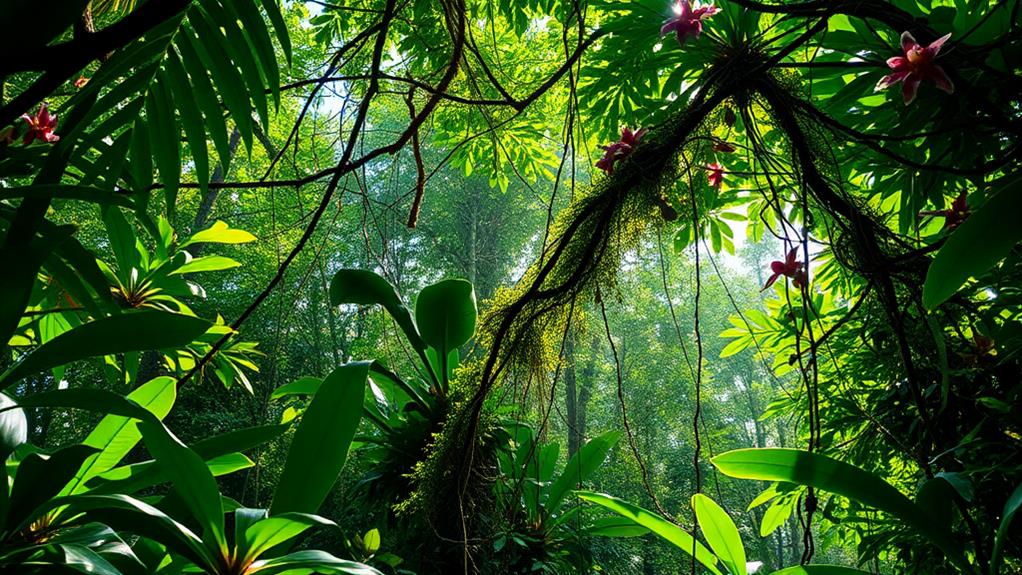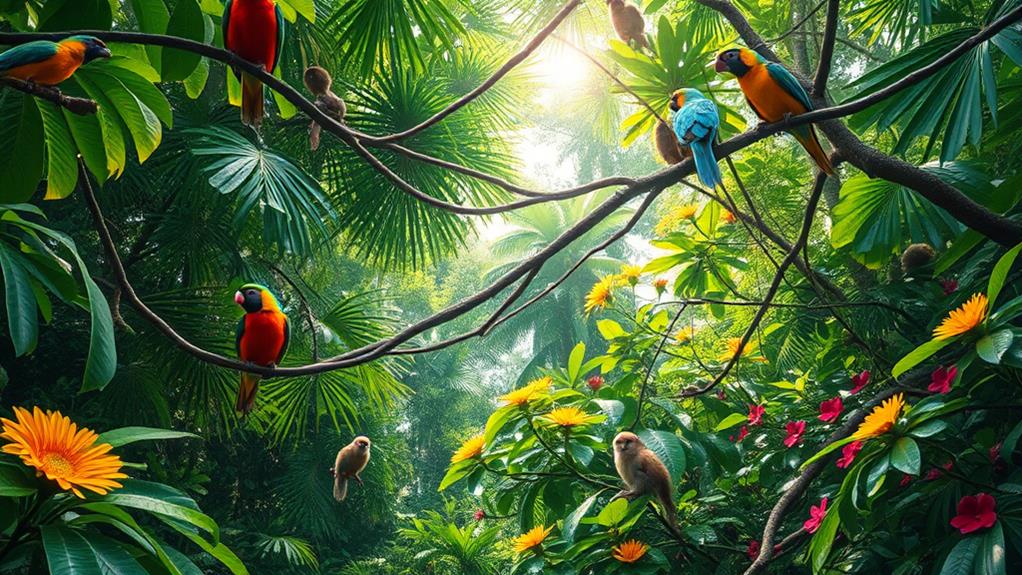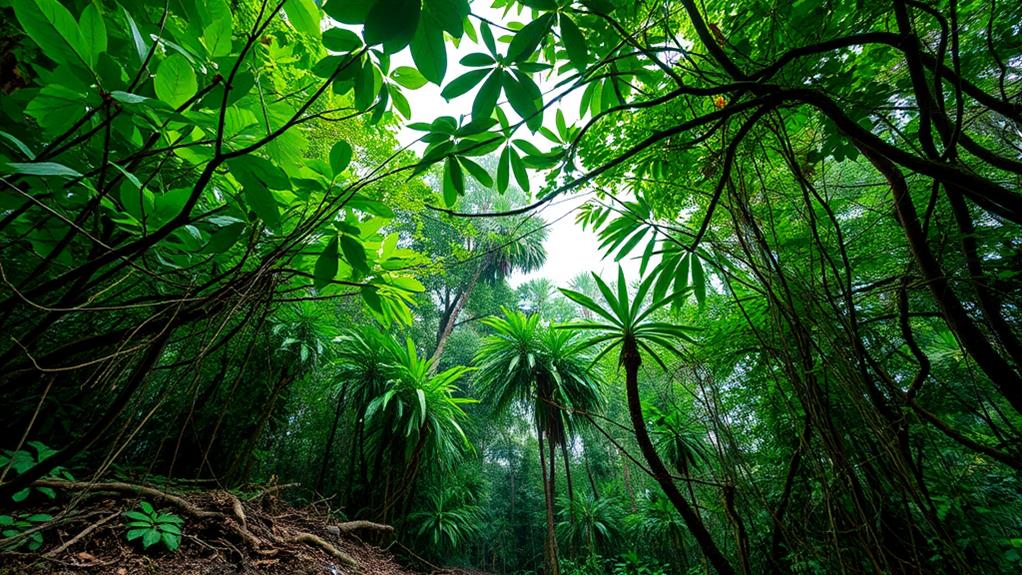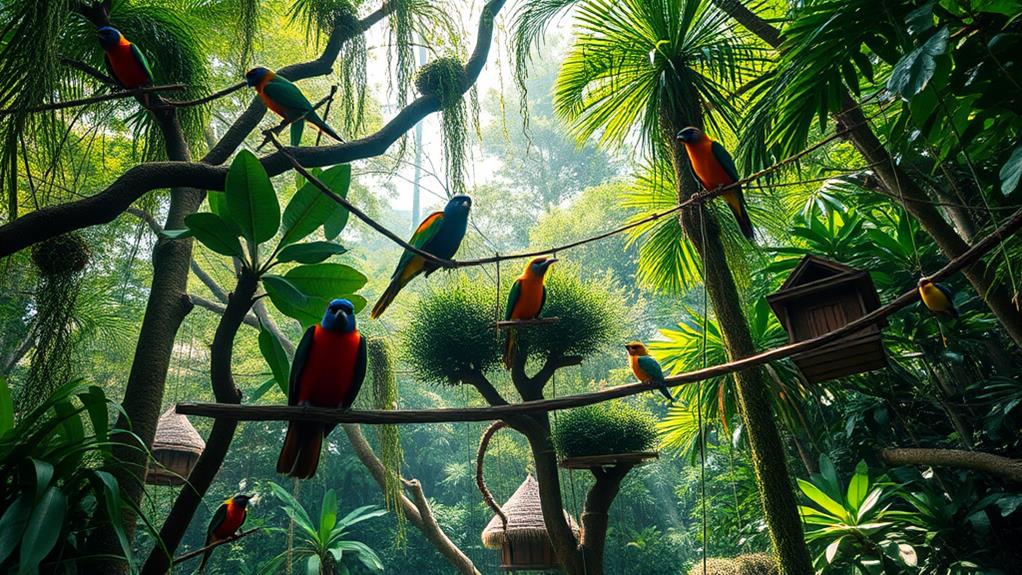Philippine rainforests are home to a vibrant ecosystem, with a rich diversity of life in the canopy. The dipterocarp forests, in particular, are known for their towering trees and unique flora and fauna. These forests provide crucial habitat for countless species, including endangered ones like the Philippine eagle and the tarsier. Unfortunately, due to deforestation and habitat loss, the future of the Philippine rainforests and their diverse ecosystem is increasingly at risk.
Dipterocarp trees dominate the landscape, stretching high into the air. Among the unique plants and animals, endangered species like the Philippine Eagle and Tamaraw require urgent conservation efforts.
These species, along with over 510 endemic species, contribute to this biodiversity hotspot.
Habitat loss and illicit logging threaten their survival, making conservation efforts crucial. Currently, only 10% of these vital ecosystems are protected.
To enhance conservation, engaging local communities and promoting sustainable practices are essential.
Overview of Philippine Rainforests

The Philippine Rainforests: A Biodiversity Hotspot Under Threat
Rich Biodiversity
The Philippine rainforests, spanning approximately 9,542,000 hectares, are nestled within the vibrant ecoregion of the Philippines and Sulu Sea Tropical Forests.
This region boasts an astonishing variety of flora, featuring dominant dipterocarp trees and unique endemic species like the Rafflesia and Waling-Waling orchids. These plants not only enhance ecological complexity but also support a diverse array of fauna, including critically endangered species such as the Philippine Eagle and the unique Tamaraw and Philippine Mouse-Deer.
Threats and Conservation Efforts
Despite this rich biodiversity, the rainforests face significant threats. Over three-fourths of these vital ecosystems have been lost due to logging, urban development, and human encroachment.
Currently, only about 10% of the rainforests are protected. The urgency for conservation efforts couldn't be clearer.
Sustainable practices are essential for safeguarding the remaining biodiversity. Engaging in these efforts not only preserves unique species but also ensures the ecological balance that sustains countless life forms.
Importance of Conservation
By supporting conservation initiatives, you can contribute to a future where the Philippine rainforests continue to thrive, maintaining their status as a global biodiversity hotspot. This is crucial because the rainforests' ecological balance is essential for sustaining life forms.
Unique Plant Species
The Philippine rainforests are home to an extraordinary variety of unique plant species that play a crucial role in the ecosystem. These rainforests are a biodiversity hotspot, featuring five endemic Rafflesia species, famous for their massive, parasitic flowers that can reach up to 1 meter in diameter. One notable example is the Rafflesia speciosa, which is found only in the Philippines.
The rainforest canopy is dominated by towering Dipterocarp trees. These trees, such as Dipterocarpus and Anisoptera, can grow up to 60 meters tall and are essential for maintaining ecosystem structure and providing habitat for countless organisms. The Dipterocarpus turbinatus, for instance, is a common species found in Philippine rainforests.
Plant families contribute significantly to the area's ecological complexity. Diverse plant families, including Annonaceae, Bombacaceae, and Meliaceae, thrive in the rainforest. The Annonaceae family, which includes species like the Annona muricata, is known for its fruit-bearing trees.
Plants have unique adaptations to survive in the cloud forest environment. Small, waxy leaves in the upper canopy are designed to retain moisture, highlighting the remarkable resilience and specialization of vegetation in this environment.
Preserving this irreplaceable natural treasure is crucial, as it provides habitat for countless organisms and maintains ecosystem structure.
Animal Diversity

Philippine Rainforests: A Hub of Unique Biodiversity
The Philippine rainforests support an astonishing array of animal life, with over 510 species of mammals, birds, amphibians, and reptiles found nowhere else in the world. This rich biodiversity is attributed to the unique plant species that thrive in these rainforests.
Endemic Species
Some notable endemic species found in the Philippine rainforests include:
| Species | Description |
|---|---|
| Philippine Eagle | A top predator, crucial for ecological balance. |
| Philippine Tarsier | One of the smallest primates, nocturnal, with large eyes. |
| Tamaraw | A critically endangered mammal, adapted to rainforest life. |
| Philippine Mouse-Deer | A small, elusive deer facing habitat loss. |
| Isabela Oriole | Once thought extinct, now a symbol of conservation success. |
Ecological Balance and Conservation
The Philippine Eagle reigns supreme in this ecosystem, maintaining ecological balance crucial for survival. In contrast, the Philippine Tarsier thrives in the dense foliage due to its unique nocturnal habits. However, threats like habitat loss and hunting jeopardize endemic mammals such as the Tamaraw. The Philippine rainforests showcase a wealth of species, highlighting the urgent need for conservation efforts to protect these vulnerable populations and preserve their unique biodiversity for future generations.
Endemic Species Significance
Endemic Species in the Philippine Rainforests: A Vital Component of Ecological Health
The Philippine rainforests are home to a staggering 510 unique species of mammals, birds, amphibians, and reptiles found nowhere else in the world. This makes the Philippines a global biodiversity hotspot. Among these endemic species, the Philippine Eagle, a critically endangered top predator, and the Philippine Tarsier, one of the world's smallest primates, are two notable examples.
The Importance of Habitat Conservation
The presence of unique mammals like the Tamaraw and Philippine Mouse-Deer highlights the need for robust habitat conservation efforts.
These species play vital roles in their ecosystems, influencing food webs and promoting ecological balance. For instance, the Tamaraw, a dwarf buffalo, helps maintain the forest's grassland ecosystem.
Threats to Endemic Species and the Need for Conservation
However, many endemic species, like the Isabela oriole, face dire threats from habitat loss and human activities.
Conservation efforts are urgently needed to protect these species and the ecosystems they inhabit. By prioritizing the conservation of these unique forms of life, we safeguard the Philippines' rich biodiversity and reinforce the health of the ecosystems that depend on them.
Ecological Threats and Challenges

The Philippine rainforests face severe ecological threats, primarily due to human activities.
The destruction of natural habitats is a significant concern, with over three-fourths of the forests lost to logging, shifting cultivation, and rapid urban development. This has led to habitat fragmentation, pushing endemic species like the critically threatened Isabela oriole closer to extinction.
Illicit logging worsens the situation, contributing to biodiversity decline and increased competition for resources among surviving species. Currently, only 10% of the rainforests are protected, far short of the 43% target.
This highlights the urgent need for effective conservation efforts to prevent irreversible damage to the ecosystem.
Immediate action is necessary to safeguard the future of the Philippine rainforests and their unique species. Engaging in conservation initiatives is crucial to preserving the rich biodiversity and ecological services these forests provide.
Conservation Efforts
Protecting the Philippine Rainforests Requires a Multifaceted Approach
To address the urgent need for conservation in the Philippine rainforests, a multifaceted approach is necessary. Only 10% of the original habitat remains, making it crucial to expand protected areas to include Key Biodiversity Areas outside existing reserves. This strategy will enhance the safeguarding of unique species and ecosystems at risk.
Engaging Local Communities is Vital for Conservation
Local communities must be engaged in conservation initiatives to promote sustainable forest management. By doing so, a sense of ownership over natural resources is cultivated, leading to more effective stewardship. This approach also supports the recovery of endemic species threatened by habitat loss.
Restoration and Sustainable Practices are Essential
Restoring degraded habitats is crucial for enhancing biodiversity and supporting the recovery of endangered species.
Incorporating sustainable practices, such as responsible tourism and educational programs, is essential for mitigating human impacts on fragile ecosystems. These efforts not only protect the rainforest but also ensure long-term conservation success.
Collaboration is Necessary for Conservation Success
A collaborative approach involving various stakeholders is necessary to preserve the rich biodiversity of the Philippine rainforests for future generations.
Your involvement and support can make a significant difference in these conservation endeavors.
The Role of Sustainable Practices

Sustainable practices are vital to preserving the Philippine rainforests, which have lost over three-fourths of their natural forests due to logging and urban development. Engaging local communities in conservation efforts is crucial, as it encourages sustainable forest management, which not only safeguards biodiversity but also offers economic benefits through ecotourism.
Agroforestry techniques can boost land productivity while maintaining forest cover, thus preserving critical habitats for endemic species. For instance, integrating trees into farming systems can increase crop yields, reduce soil erosion, and provide habitat for native species.
Establishing protected areas based on biodiversity assessments is essential to ensure that key biodiversity areas remain intact, securing the survival of unique flora and fauna native to the region. This involves identifying areas with high conservation value and implementing measures to prevent human activities that harm the environment.
Raising awareness about sustainable practices is crucial for fostering a collective responsibility towards these irreplaceable ecosystems. By understanding the importance of sustainable practices, individuals can contribute to a healthier environment and the longevity of the rich biodiversity that the Philippine rainforests harbor.
Questions and Answers
What Species Diversity Is in the Philippines and the Tropical Rainforest?
The Philippines is home to astounding species diversity, with many endemic species found nowhere else in the world.
The Philippine Eagle, for instance, is a critically endangered species that can only be found in the country's forests. Another example is the Philippine Tarsier, a small, nocturnal primate with enormous eyes.
This diversity is ecologically important because many organisms rely on each other for survival.
In a tropical rainforest, trees provide shelter and food for various animals, while insects and microorganisms help break down organic matter to fertilize the soil.
However, conservation challenges threaten the existence of these unique species and their ecosystems.
Deforestation and habitat loss are significant threats, as they destroy the natural habitats of many species.
To preserve the Philippines' incredible biodiversity, it's crucial to address these issues.
What Is an Animal That Would Live in the Canopy of a Rainforest in the Philippines?
The Philippine Tarsier is a fascinating inhabitant of the rainforest canopy in the Philippines.
This nocturnal creature has remarkable arboreal adaptations that enable it to thrive in its habitat. Its large eyes provide enhanced night vision, allowing it to navigate and hunt in the dark.
Additionally, its powerful limbs facilitate impressive leaps, making it an agile and effective hunter.
The Philippine Tarsier's life in the rainforest canopy enables it to efficiently hunt insects and small vertebrates. This highlights the intricate balance of the ecosystem, where each species plays a vital role.
Protecting unique species like the Philippine Tarsier is crucial for maintaining the biodiversity and health of these vital habitats.
What Is the Purpose of the Canopy in the Rain Forest?
The canopy's structure is essential for a rainforest's ecology. It efficiently absorbs light, enabling photosynthesis and supporting a diverse range of plant life. For example, the dense foliage of the canopy allows plants to undergo photosynthesis, which in turn supports the growth of giant trees, vines, and epiphytes.
The canopy regulates the rainforest's climate. By absorbing light, it stabilizes temperatures and maintains high moisture levels below. This creates a suitable environment for plants and animals to thrive.
The canopy provides habitats for numerous animal species. It offers shelter, food, and breeding grounds for a wide variety of animals, such as monkeys, birds, and insects.
The canopy's complex structure also facilitates pollination and seed dispersal, ensuring the continued growth and diversity of plant species.
The canopy is crucial for maintaining biodiversity. By supporting a vast array of plant and animal life, it ensures the survival of numerous species and promotes overall biodiversity in the ecosystem.
What Are the 5 Rainforests in the Philippines?
The Philippines is home to five major rainforests: the Palawan, Mindanao, Luzon, Sulu, and Visayas. Each rainforest has unique biodiversity, shaped by the tropical climate. The tropical climate has created diverse ecosystems, with Palawan being known for its mangrove forests and Mindanao for its mountainous regions.
Conservation efforts are crucial in the Philippines, as deforestation threatens these ecosystems. Deforestation leads to habitat loss, soil erosion, and decreased water quality.
Indigenous cultures rely on these forests for resources and identity, highlighting the need for sustainable practices. For example, the Tagbanua people of Palawan depend on the forest for food, shelter, and traditional medicine.
By understanding and protecting these rainforests, individuals can contribute to preserving not just the environment but also the rich heritage of local communities. This can be achieved through sustainable forest management, reforestation efforts, and supporting local conservation initiatives.